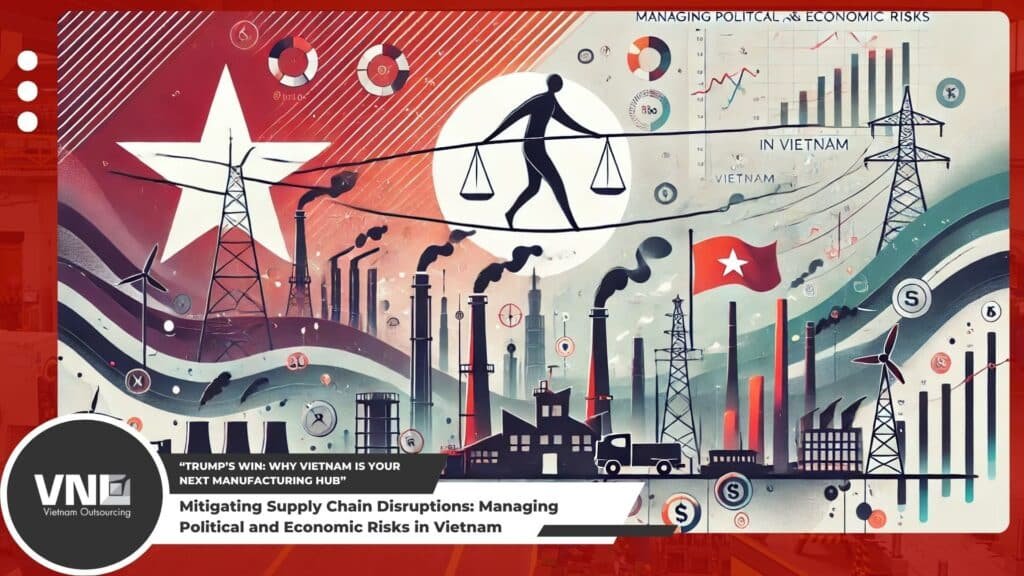Introduction
Vietnam’s emergence as a global manufacturing hub has positioned it as a critical player in international supply chains. However, like any growing economy, Vietnam is not immune to challenges such as currency fluctuations, geopolitical dynamics, and trade policy changes.
In 2024, as the global trade environment adjusts to Donald Trump’s re-election and continued emphasis on “America First” policies, Western businesses must navigate these uncertainties carefully. This article explores the political and economic risks associated with sourcing from Vietnam factories and offers strategies to ensure resilient supply chains.
Key Political and Economic Risks
1. Currency Fluctuations
The Vietnamese đồng (VND) is relatively stable compared to other emerging market currencies but remains sensitive to external factors:
- In 2023, the VND depreciated by 3.2% against the U.S. dollar, influenced by global inflation and rising U.S. interest rates (World Bank).
- For Western businesses sourcing products such as sheet metal components or aluminum products, even small currency fluctuations can significantly impact procurement costs.
2. Trade Policy Uncertainty
With Donald Trump’s return to the White House, U.S. trade policies have refocused on reducing trade imbalances:
- Vietnam’s trade surplus with the U.S., which reached $110 billion in 2023, could face additional scrutiny or tariffs.
- Potential policy changes could affect the cost competitiveness of exports like precision machinery and die-cast components.
3. Dependence on Raw Material Imports
Vietnam’s manufacturing sector, though robust, relies heavily on imported raw materials:
- Nearly 70% of steel and electronic components used in production come from China (Vietnam Ministry of Industry and Trade, 2024).
- Disruptions in China’s supply chain due to geopolitical tensions or COVID-related restrictions can ripple through Vietnam’s manufacturing ecosystem, impacting the availability of copper components or materials for valves.
Strategies to Mitigate Risks
1. Managing Currency Volatility
Western companies can adopt financial strategies to counter the impact of exchange rate fluctuations:
- Forward Contracts: These allow businesses to lock in favorable exchange rates for future transactions, ensuring predictable costs.
- Dual-Currency Pricing: Structuring contracts in both VND and USD to balance risks across currencies.
For instance, using forward contracts for sourcing railguard safety systems or roof jacks can shield businesses from unexpected cost increases due to currency shifts.
2. Leveraging Trade Agreements
Vietnam’s participation in global trade agreements provides significant opportunities to offset risks:
- EU-Vietnam Free Trade Agreement (EVFTA): Reduces tariffs on many metal products exported to the EU, making them cost-competitive despite potential changes in U.S. policies.
- Comprehensive and Progressive Agreement for Trans-Pacific Partnership (CPTPP): Enhances Vietnam’s access to markets like Canada, Japan, and Australia, diversifying its export destinations.
Western companies should work closely with Vietnamese Metal Manufacturer to understand and benefit from these agreements.
3. Building Strong Local Relationships
Strong partnerships with local suppliers and Vietnam factories are critical for navigating challenges effectively:
- Collaborative Planning: Working with local manufacturers ensures better coordination on sourcing and production schedules, particularly for complex products like hydraulic press machine frames or main chutes.
- Alternative Sourcing: Identifying secondary suppliers within Vietnam or neighboring ASEAN countries helps mitigate disruptions caused by raw material shortages.
4. Enhancing Supply Chain Visibility
Investing in technology to monitor and manage supply chains can reduce risks:
- Real-Time Tracking: Using digital tools to monitor the flow of goods, from raw material procurement to final product delivery.
- Data Analytics: Analyzing market trends to anticipate and respond to potential disruptions, such as rising material costs for die-cast components.
Proactive Risk Management
Beyond immediate strategies, businesses should adopt a proactive approach to ensure long-term resilience.
Regular Risk Assessments
Conducting regular reviews of political and economic conditions can help businesses adapt to changing circumstances. Key areas to monitor include:
- Currency trends and inflation rates.
- Policy updates under the Trump administration, particularly concerning tariffs on Vietnamese exports.
Diversifying Supply Chains
Reducing reliance on a single supplier or market ensures stability in the face of disruptions. For example, sourcing precision machinery or sheet metal products from multiple factories within Vietnam can reduce risks while maintaining quality.
Local Expertise
Partnering with Vietnamese procurement experts or engineering consultants provides valuable insights into market dynamics and regulatory changes. Their expertise can streamline processes and ensure compliance with local laws.
Conclusion
Vietnam offers significant advantages as a manufacturing hub, but political and economic risks must be carefully managed to ensure uninterrupted supply chains. From currency volatility to shifting trade policies, challenges are an inherent part of doing business in any emerging market.
By adopting strategies like currency hedging, leveraging trade agreements, and fostering strong local partnerships, Western companies can effectively mitigate these risks. With its growing industrial capacity and commitment to international standards, Vietnam factories remain a reliable and competitive choice for sourcing in 2024 and beyond. More insight can be found at Compliance & Supply Chain in Vietnam.







